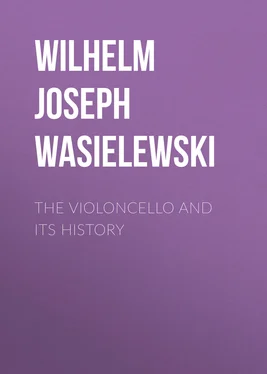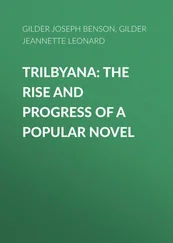Wilhelm Joseph von Wasielewski - The Violoncello and Its History
Здесь есть возможность читать онлайн «Wilhelm Joseph von Wasielewski - The Violoncello and Its History» — ознакомительный отрывок электронной книги совершенно бесплатно, а после прочтения отрывка купить полную версию. В некоторых случаях можно слушать аудио, скачать через торрент в формате fb2 и присутствует краткое содержание. Жанр: foreign_antique, foreign_home, music_dancing, на английском языке. Описание произведения, (предисловие) а так же отзывы посетителей доступны на портале библиотеки ЛибКат.
- Название:The Violoncello and Its History
- Автор:
- Жанр:
- Год:неизвестен
- ISBN:нет данных
- Рейтинг книги:3 / 5. Голосов: 1
-
Избранное:Добавить в избранное
- Отзывы:
-
Ваша оценка:
- 60
- 1
- 2
- 3
- 4
- 5
The Violoncello and Its History: краткое содержание, описание и аннотация
Предлагаем к чтению аннотацию, описание, краткое содержание или предисловие (зависит от того, что написал сам автор книги «The Violoncello and Its History»). Если вы не нашли необходимую информацию о книге — напишите в комментариях, мы постараемся отыскать её.
The Violoncello and Its History — читать онлайн ознакомительный отрывок
Ниже представлен текст книги, разбитый по страницам. Система сохранения места последней прочитанной страницы, позволяет с удобством читать онлайн бесплатно книгу «The Violoncello and Its History», без необходимости каждый раз заново искать на чём Вы остановились. Поставьте закладку, и сможете в любой момент перейти на страницу, на которой закончили чтение.
Интервал:
Закладка:
3
The “big fiddle” of the sixteenth century must not be confounded with the stringed instrument of that time, of which the pitch answered to our modern Contra-basso, and in Italy was already called “Violone,” as appears from Laufranco’s “Scintille,” 1533.
4
The word “beschriben” refers to the letters which, for the convenience of the player, it was the custom to mark for the fingers on the fingerboard.
5
The artist who drew the sketches of the instrument for Gerle’s “Musica Teutsch” has left out the bridge in the “great viola.” See page 2.
6
See the article “Kerl.”
7
Also at the present time it is a family name. We need only mention G. H. Bruno Kerl, Professor of the Royal Berg Academy at Berlin.
8
Other authorities, however, say he was a Breton—Fétis, Casimir Colomb &c.—( Tr. )
9
The name Duiffopruggar doubtless came from the same source as the surname Tieffenbrucker, still existing in South Germany.
10
Mr. Heron Allen in his “Violin Making, &c.,” page 74, says that two were recovered.—( Tr. )
11
The same Prince to whom Corelli dedicated his “Concerti Grossi,” published in 1712.
12
Herr Obernetter, of Munich, has taken two beautiful photographs of this richly decorated instrument, which reproduce with great accuracy all its peculiarities. As far as I know they can still be purchased.
13
Here may be mentioned also a third magnificent gamba, that of Vincenzo Ruger, said to have been made in Cremona in 1702. It is distinguished not only for its beautiful exterior in every respect, but also by an extraordinarily sonorous and unusually fine quality of tone, which combines the resonant character of the gamba with that of the violoncello. The latter circumstance is attributed to the fact that the back, which is usually flat in the ordinary gamba, is arched in this one. This instrument, which has been lately purchased by the Prussian Government for the Berlin Museum, was formerly in the possession of Herr Paul de Wit, in Leipsic. The account of instrument making published by him contains (Vol. VI., No. 21) a description and illustration of the gamba in question.
14
Violuntzes is synonymous with the old French instrument, violonsse. Vide Grimm’s Dictionary of the German Language.
15
The Kammerthon or chamber-pitch, as distinguished from the obsolete “Chorton” or choir-pitch, which formerly prevailed in German churches, was a tone, or even more, higher than the secular pitch.—( Tr. )
16
“Faburden,” according to Mr. Niecks.—( Tr. )
17
Concerning this, see my “History of Instrumental Music” in the Century , page 107.
18
By the word concert, Mersennus means concerted piece.
19
Maugars is called in the “Historiettes de Tellemant des Réaux,” as Fétis informs us, the “greatest fool that had ever lived.” His “Réponse faite à un curieux” (completely unprejudiced, although somewhat conceited) in no way agrees with this. It is easy to discover that Maugars was not liked by his countrymen, because he openly declared that French music was far behind the Italian. On that account he had incurred the displeasure of French artists. The Parisian musician, Corrette, in the eighteenth century, was guilty of the same offence. He had been candid enough to say to the French that the standard of French violin playing of the eighteenth century was, compared to the Italian, in a disorganised condition. In retaliation they called his pupils scornfully “les anachorètes” (“les ânes à Corette”).
20
I give this and the following quotations from Maugars’ writings, according to my translations in the monthly parts of the “History of Music,” published in the year 1878.
21
The English writers on music affirm that the well-known composer, Ferabosco, who was born at Greenwich in the second half of the sixteenth century, and who was also called Alfonso, was the son of the above Ferabosco, with which the remarks of Maugars agree. Fétis doubts the truth of the assertion made by the English writers on music. The younger Ferabosco appears also to have been a gamba player, for he published, in the year 1609, in London, “Lessons for one, two, and three viols.” He died in 1665.
22
See my work “The Violin and its Masters,” Part ii., p. 203.
23
His name was usually written Sympson, but he sometimes himself spelled it Simpson.—( Tr. )
24
This seems to have been the title of the first edition, a copy of which is in the possession of Messrs. Hill, of New Bond Street.—( Tr. )
25
This work contains, besides the viola tutor, an introduction to violin playing. It is the first attempt at a violin school.
26
Thomas Campion was a physician, poet, and musician in the reign of Queen Elizabeth, and an authority on music. He published two books of Ayres, and various other pieces, besides the above.—( Tr. )
27
He has already been mentioned, p. 13.
28
Michael Corrette ascribes this to Sainte-Colombe in his violoncello school, which appeared in 1741, concerning which we shall speak farther on.
29
Concerning this instrument, Mattheson says: “The Angelique, somewhat resembling the lute, must have been far easier to play, and has more cords or strings, which one can accurately touch by reason of their arrangement without moving the left hand much. There is nothing specially besides to remember.” It was, therefore, an instrument of the lute kind.
30
He was perhaps a brother or relation of the instrument maker Tielke mentioned pp. 7and 8of this work.
31
Compare p. 8.
32

It is worthy of observation that this second fugue (D minor) has the theme which Mozart, nearly 100 years later, made use of for the second Finale of the “Magic Flute.” There is no doubt this was purely accidental, as Mozart could hardly have seen Schenk’s work.
33
A MS. copy exists in the Royal Library at Berlin.
34
The MS. is preserved in the Royal Library at Berlin.
35
It is to be found in the autograph collection of Count Wimpfen at his estate near Gratz.
36
According to Fürstenau, Abel was engaged as violoncellist at Dresden. See his “History of Music and of the Theatre at the Elector of Saxony’s Court,” Vol. II., p. 240.
37
Sebastian Bach’s youngest son, Joh. Christian, was born in 1735, in Leipsic, and died in London in 1782, whither he had gone in 1759 as Band Conductor.
38
According to Pohl, the number of these metal strings was raised to twenty-seven. (S. C. F. Pohl: “Haydn,” I., 250.) Information regarding the barytone and barytone compositions are to be found there.
Читать дальшеИнтервал:
Закладка:
Похожие книги на «The Violoncello and Its History»
Представляем Вашему вниманию похожие книги на «The Violoncello and Its History» списком для выбора. Мы отобрали схожую по названию и смыслу литературу в надежде предоставить читателям больше вариантов отыскать новые, интересные, ещё непрочитанные произведения.
Обсуждение, отзывы о книге «The Violoncello and Its History» и просто собственные мнения читателей. Оставьте ваши комментарии, напишите, что Вы думаете о произведении, его смысле или главных героях. Укажите что конкретно понравилось, а что нет, и почему Вы так считаете.












![Edward Ellis - Adrift on the Pacific - A Boys [sic] Story of the Sea and its Perils](/books/753342/edward-ellis-adrift-on-the-pacific-a-boys-sic-s-thumb.webp)